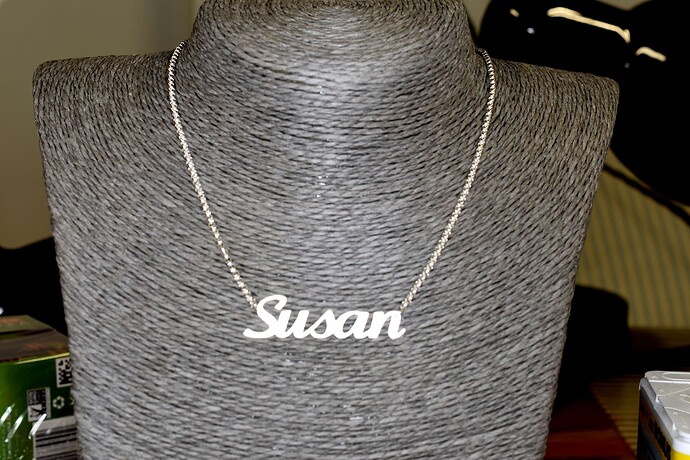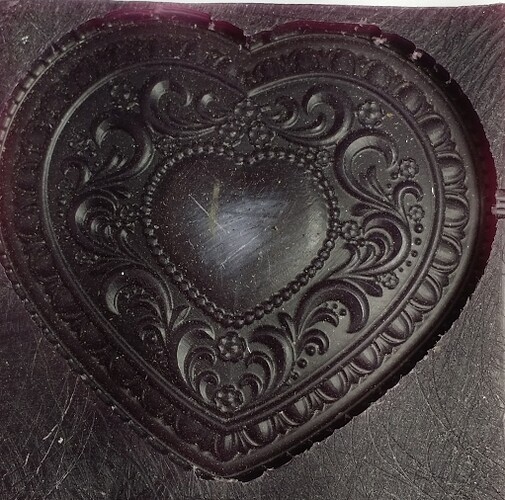In case anyone is interested, I am selling my Taig metal lathe and a large collection of unused tools that go with it. It is listed on FB Marketplace. I have decided that a mill would serve my purposes better, but I need to sell the Taig first. I would appreciate any suggestions about a small, possibly CNC, mill. Thanks…Rob
Rob, my family chipped in and got me a Carbide 3D model 883 mill from Rio for Christmas some years ago. The model has been superseded by a newer model with some practical refinements and a more powerful motor. Or higher RPM. Mine does 10,000 RPM max.
While high power sounds great the fact is you can push small bits only so hard and then they break. So a more powerful motor may not be of any advantage. I have to make multiple light cuts to get a deep cut.
Higher RPM may be good. I do not know but it is worth looking into if you can ask a machinist. A problem I have with milling silver is that some of the swarf can remain in the cut, say if you are milling a channel, and it hardens in the channel. The point being I don’t get smooth, polished cuts. That includes when lubricating with liquid Bur Life (which makes a mess). On the other hand, possibly much lower RPM might work. I have never tried it. A Carbide 3D guy told me to not go below 6,000 RPM, but that might be for reasons that don’t apply to my use.
I wish I remembered the Orchidean who sells mills. His website had quite a variety of models, some selling for much less than mine.
The other part of the equation is the CAD software you will use. That’s at least as important as the choice of mill. And the software needs to generate the gcode compatible with your mill. There’s a really long list of gcode variants!
If you ever want to mill more in the round, a 3-axis mill will not cut it. (Sorry). they are top-down only.
I really enjoy CAD/CAM but looked into 3D printing because of what I cannot mill.
Here’s a simple project I milled:
That’s strictly 2D. 2.5D is where you have multiple levels, not just a profile cut in sheet. You can also mill 3D top-down with a 3-axis mill, like an eagle’s head engraving, but that requires 3D CAM software.
If you want quality engraving, you need to ask someone about milling speed. Since few likely mill in silver, maybe those who mill aluminum? I have not found silver to cut anywhere near as cleanly as with a graver.
Sorry for the long post.
Best of luck!
Neil
Neil…Thanks! I always enjoy and appreciate whatever you post…Rob
To show differences, here’s a 3D design milled in Ferris carving wax, which took no time at all, vs the better part of a day it would take in silver. The center scuffing is my fault. Note the smooth texture and fine details in the wax, best seen on the right side.
The heart is just 43mm tall.
This was milled first with a larger ball end mill bit to remove a lot of material, then refined with a 0.8mm jeweler’s ball bit. Even smoother texture could be possible if one could get smaller ball bits. I think 0.8mm is the smallest.
The design is a stock piece. I’m nowhere near capable of that kind of 3D complexity in CAD.
Neil A
Neil…I have bought burs from Lasco. They offer round friction grip carbide dental burs down to .5mm. They are 1/16" shafts, so you need to be able to chuck that small a bur. Following is a link…Rob
Rob, many thanks! 1/8" is the collet size for my mill so I’d need to get an adapter, which I will. To use 3/32 jeweler’s bits I insert this Foredom collet with the bit:
Neil A
Thanks Rob. I think. That’s a very dangerous place for a tools addict. My first order is in, likely more to follow.
Neil A
You can also change collet sizes, this is easily done. or you can make your own collet from a piece of steel rod (drill a hole the size you need) then cross cut with a jewelers saw.
I’ve milled a bunch of sterling, although it was some years ago. Hardened sterling cut’s cleaner, which is different than what we usually do with annealing, if the metal is too soft it smears. burrs down to 1/32 inch, 10,000 rpm, for engraving I used a v carving point, you can made one out of a piece of carbide stock and a diamond wheel; steel works also, won’t last as long. You can also mill nephrite; grinding is more an apt term than milling, Lasco makes some good burrs. Keep in mind surface feet per minute when cutting; that is, the SFM at the outside of a burr or wheel is different than that at the the center (essentially zero). Also for sterling, need sharp tools, tiffany’s recommended to me to use a diamond cuttings edge if possible. Don’t think any of my sterling work is up, but jade and certainly aluminum pieces are if you want to see what can be done with milling, check www.tucsongemshows.com
Hi
wow! nice work!
julie
Hello Rob: sad to see you are selling a lathe I hope you have another machine as it is so handy to have a lathe.
Regarding a CNC mill, it is also a very handy tool with some uses beyond machining wax models. As I own an old Dynamyte 2800 CNC re-controlled with modern electronics I can say that diamond drag engraving is very handy to follow either real engraving or piercing a piece with very high precision surpassing the printed paper glued template by a long shot.
Previous posts already mention that jewellery used metal don’t machine very well, to me the worst experience was trying to machine German silver and destroying the tool and the piece before I managed to press the estop, silver and copper are no better.
The learning curve is steep as you may have to cascade different software packages but at the end it can be very rewarding.
Hi Carlos,
when you say “diamond drag” are you referring to a manual pantograph?…or is it a type of CNC machine?
(i have a vintage manual drag pantograph…i never thought to use a pierced or engraved template…genius!…i have bought a few custom templates in brass and acrylic, but your idea sounds faster and less expensive…)
julie
Hi Julie:
Diamond drag is a common engraving tool used either by a CNC mill or a pantograph, it is a spring loaded diamond tip to scratch engrave the metal as it is non rotating. I also own a WW2 vintage Taylor & Hobson pantograph and I make templates using the CNC mill, it expands the potential of the pantograph to modern times !!.
Hi Neil,
I just had a thought…can you blow the swarf away as you mill…?…
(my mind has recently turned toward my pantograph…which is manual…and i have always wondered about swarf with the rotary pantographs…the thought of blowing swarf across my mirror finish polish gives me hives!)
julie
…can you blow the swarf away as you mill…?
Julie, I have tried vacuuming close to the bit with the intention of getting swarf out of the way of the cutting bit for repeat, deeper passes. I thought vacuuming to be better than blowing silver all over the machine bed. But an advantage to milling silver is leaving the machine to do work for me while I do something else, which is negated if I have to stand there and cater to it.
I didn’t want to rig up some kind of vacuum attachment that might interfere with the cutting head’s movement. And the vacuuming didn’t seem to do much good anyway.
After the fact I have tried using a graver to remove the swarf from a cut channel and it was not easy going, so it isn’t just that swarf was left behind in a cut, but that grains seem to fuse with the piece. Flooding the area with liquid Bur Life for cooling and lubrication may have helped a little, but not enough, and isn’t worth the mess.
As suggested by gemcarver I will try precipitation hardening my stock the next time around.
Another possibility might be a final, faster pass or two through the finished cut to remove the fused swarf.
Either try is unlikely to be anytime soon as I’m deep into remodeling my house and my shop is so full of building materials as to be unusable.
Neil A

